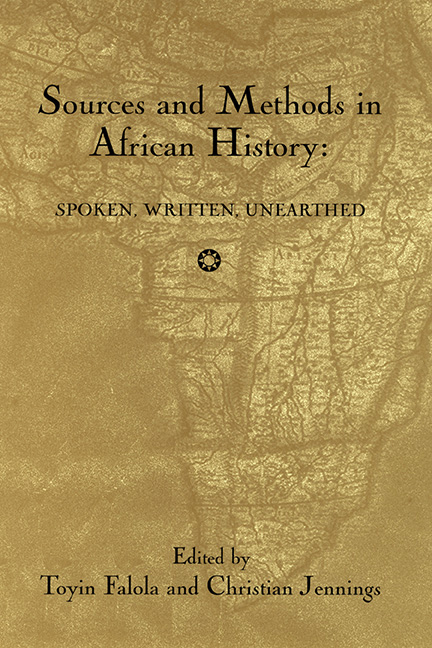Book contents
- Frontmatter
- Dedication
- Contents
- Acknowledgments
- Introduction
- Part I Archaeological Sources
- 1 Section Introduction: Archaeology and History
- 2 Trouble with Siblings: Archaeological and Historical Interpretation of the West African Past
- 3 Material Culture and Cadastral Data: Documenting the Cedarberg Frontier, South Africa, 1725–1740
- 4 Chronology, Material Culture, and Pathways to the Cultural History of Yoruba-Edo Region, 500 B.C.–A.D. 1800
- 5 For Trinkets Such As Beads: A Revalorization of Khoisan Labor in Colonial Southern Africa
- Part II Africa and the Atlantic World
- Part III Documentary Sources
- Part IV Oral Tradition
- Part V Innovative Sources and Methods
- Contributors
- Index
1 - Section Introduction: Archaeology and History
from Part I - Archaeological Sources
Published online by Cambridge University Press: 25 October 2017
- Frontmatter
- Dedication
- Contents
- Acknowledgments
- Introduction
- Part I Archaeological Sources
- 1 Section Introduction: Archaeology and History
- 2 Trouble with Siblings: Archaeological and Historical Interpretation of the West African Past
- 3 Material Culture and Cadastral Data: Documenting the Cedarberg Frontier, South Africa, 1725–1740
- 4 Chronology, Material Culture, and Pathways to the Cultural History of Yoruba-Edo Region, 500 B.C.–A.D. 1800
- 5 For Trinkets Such As Beads: A Revalorization of Khoisan Labor in Colonial Southern Africa
- Part II Africa and the Atlantic World
- Part III Documentary Sources
- Part IV Oral Tradition
- Part V Innovative Sources and Methods
- Contributors
- Index
Summary
From the nineteenth century, when Heinrich Schliemann set out to find the legendary city of Troy by following descriptions in Homer's Iliad, archaeology has often served history in a “validationist” role by seeking to “prove” the existence of events, places, or personalities found in historic documents—or even epic poems. For much of the twentieth century this was one of the principal methodological strategies and goals of archaeological excavations in the holy land and Mediterranean regions. Archaeology can play a much broader role in historical studies, however, by permitting an engagement and dialogue with historical materials that can facilitate not only a validation of historical records and traditions, but also a method whereby historical questions and statements can be tested, critiqued, expanded upon, and modified by new lines of evidence. Such methodologies are especially useful in Africa, where so much of the past, particularly in the interior regions, is still unknown.
While the general goals of historical and archaeological interpretation often overlap, the methodologies and data used to formulate and evaluate hypotheses differ. A new generation of archaeologists is now becoming aware of the need to be more sensitive to the biases, limitations, and reliability of historical documents. At the same time, historians are coming to grips with the nuances of archaeological data collection and its interpretation. As a result, once can expect to find fewer instances where, for example, the earliest from a broad range of radiocarbon dates for a site is selected as the only “correct” one for an event or occupation in question. Archaeological data also have their inherent biases and limitations; some of these are statistical, while others stem from the biological or cultural-interpretive realms from which the data were drawn and/or interpreted.
Each of the four papers presented here explores the use of archaeological and historical data in slightly different ways. Changes in settlement pattern, in population distribution, and in the spatial distribution and extent of trading networks, for instance, are all issues that are addressed in one form or another in each of the papers included here. One of the integrating features is that all to some degree use both archaeological and historical lenses to expand perspectives on the African past beyond what could be traditionally achieved by either discipline alone.
- Type
- Chapter
- Information
- Sources and Methods in African HistorySpoken Written Unearthed, pp. 3 - 6Publisher: Boydell & BrewerPrint publication year: 2003

